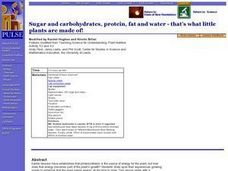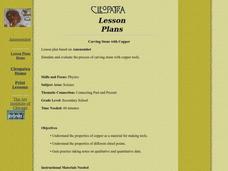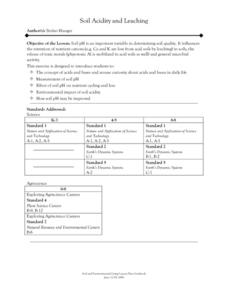The New York Times
Investigating the Heroin and Prescription Opioid Epidemic
How bad is the opioid crisis in America? Has it gotten worse in the last few decades? Why? High schoolers delve into these questions with a thorough and thoughtful lesson from The New York Times on heroin prescription opioids. Starting...
Theodore Roosevelt Association
Roosevelt's Legacy: Conservation
The legacy of Theodore Roosevelt carries through modern American politics, economics, foreign policy, and society. But his proudest and most profound efforts were in the world of conservation, and in preserving the natural beauty of...
DiscoverE
Textbook Support Challenge
Textbooks are heavier than a sheet of paper, so how can paper hold up a textbook? Young engineers create a structure out of paper that can support a textbook. To add another wrinkle, they must stay within budget and time constraints.
Curated OER
Sugar and carbohydrates, protein, fat and water - that's what little plants are made of!
Students identify photosynthesis as the mechanism by which plants convert sunlight energy into a usable energy source for plant processes. They identify photosynthesis as the mechanism by which plants create a molecule that can be used...
Curated OER
Flowers: Form and Function
Students recognize and name the parts of a flower. They explain the function of each part of a flower. Students list the steps that occur for sexual reproduction of a plant to take place. They recognize and name the male reproductive...
Curated OER
Positive and Negative Charge Using Balloons
Fourth graders observe and explain how balloons rubbed on a shirt create positive and negative charges. In this positive and negative charge lesson plan, 4th graders record their results and explain their findings.
Curated OER
Dig It Up
Students participate in an archaeological excavation to determine how archeologists make inferences about various cultures. They reconstruct the site using layers of drawings. They discuss the kinds of information they learned.
Curated OER
Characteristics of Materials
Students examine everyday materials by utilizing educational software. For this group analysis lesson, students identify several different fabrics and materials used in everyday life. Students participate in a computer activity in which...
Curated OER
How Temperature Affects Density
Students examine the effects of temperature and density in ocean currents. In this density lesson, students explain how coastal climates are impacted by ocean currents. They investigate how the ocean currents are affected by temperature...
Curated OER
Carving Stone with Copper
Students explain the properties of copper as a material for making tools and explain the properties of different chisel points. They gain practice taking notes on qualitative and quantitative data.
Curated OER
Forces and Pressure
In this forces worksheet, students will review the different types of forces and how forces are measured. This worksheet has 9 fill in the blank, 1 short answer, and 11 multiple choice questions.
Curated OER
Oceanic Habitat Zones
Students explore ocean habitats. In this oceanic environment instructional activity, students research various habitats in the ocean. Then, in a jigsaw format, students teach others in the class about the habitat they researched.
Curated OER
Soil Acidity and Leaching
Students are introduced to the concept of acids and bases and arouse curiosity about acids and bases in daily life. They are introduced to the measurement of soil pH. Pupils are introduced to the effect of soil pH on nutrient cycling...
Curated OER
Soil Detectives: The Case of the Lost Friends
Students show how soil varies across the landscape, they explain how soil can be used to solve mysteries. Pupils are introduced to techniques that would be used to distinguish soils from different places.
Curated OER
Soil Testing and Texturing
Students are introduced to soil textures and why they are important in examining soil quality. They find out how to feel the difference between soil textures. Pupils describe which soil texture is best for gardens and growing healthy...
Curated OER
Runoff with Chunky the Chicken
Students are introduced to the on-farm nutrient cycle, which explains feed to manure, to soil, and back to the feed. They are introduced to the generation of runoff during rainstorms, and the contents of runoff water are more than water...
Curated OER
Professor Profile looks over the horizon
Students are introduced to the differences that exist in soil properties with depth. They are introduced to the factors that influence a soil's development (soil forming factors). Pupils are introduced to the impact of soil of soil...
Curated OER
Colors of our Earth
Learners are introduces to soil profile classification. They remember that classification of soils is an important aspect of studying soils as it aids in predicting how soils react to weathering, transport nutrients or pollution. ...
Curated OER
Digging up the Dirt on Soil Microbes
Students are introduced to the idea of soil as a habitat for many different organisms. They are introduced to the links between the biological adaptations of an organism and the physical demands of its habitat. Pupils are introduced to...
Curated OER
Super Stream Keeper's
Young scholars are introduced to Delaware's waterways as precious resources used for drinking water, water for agricultural and industrial uses, recreational areas, and as habitats for wildlife. They are introduced to wastewater...
Curated OER
Water Cycle and Its Movement in the Soil
Students are introduced to the water cycle and water movement in soil. In this water cycle instructional activity, students explore how water moves through the water cycle and discuss water sources, natural reservoirs, soil infiltration...
Curated OER
Who's in my soil!?!...and just what do they think they're doing there?
Learners discover organisms that inhabit the soil, the beneficial an detrimental roles these organisms play, and the interactions between the organisms and their environment and other organisms. Students participate in four hands-on ...
Curated OER
The Physical Behavior of Matter
Students distinguish between three phases of matter: solid, liquid and gas, on the molecular level. They compare and predict the relative compressibility of the three phases of matter through journal writings and drawings.
Curated OER
Plasmolysis in Elodea Plant Cells
Students microscopically observe various subcellular components. They determine the effects of different salt solutions on Elodea plant cells. They detect the presence of chloroplasts, cell walls, and cell membranes of Elodea.

























